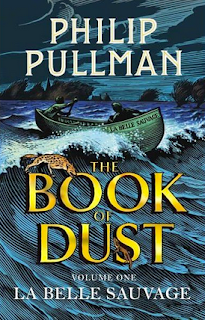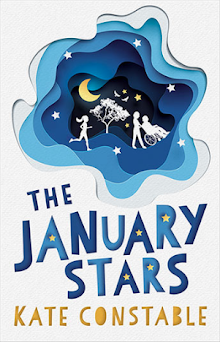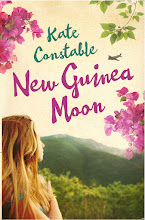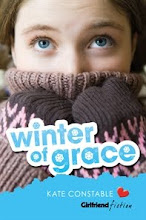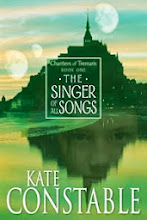I had never read this 1975 American classic, though I know it's a popular set text for primary schools, and Evie is familiar with the musical version. It was a quick and easy read, divided into very short chapters, and with a simple and straightforward story that nonetheless raises some big ideas.
Young Winnie Foster encounters a friendly family and learns their tightly-kept secret -- they have accidentally drunk from a magical spring which has given them eternal life. They will never grow older, and never die. For me, the most interesting aspect of the tale lies in Winnie's attraction to the youngest son, Jesse, who offers to share the gift with her when she turns seventeen -- though she finds it pretty easy to refuse. The book is a reflection on the pattern of life -- the Power of Becoming, as the Tremaris books would have it -- birth, change, aging and death. The Tucks have been removed from this cycle, and so their lives have become meaningless.
I don't know if I'm entirely convinced by the book's argument, but certainly I wouldn't want to live forever either, and I'm pretty sure that Winnie made the right decision.
31.1.18
30.1.18
The Mitfords: Letters Between Six Sisters
I came across The Mitfords: Letters Between Six Sisters months ago in a second hand bookshop in Sydney - at over 800 pages, it was way too heavy to bring home!
'Haven't you got that one already?' asked Michael. 'Didn't you have that in St Kilda?'
'No, no,' I said. 'That was letters between Nancy and Evelyn Waugh [mysteriously went missing, long story, I was very cross]. I don't have this one.'
So when I found it again on Brotherhood Books, I bought it, and I've spent many happy hours in this hot week trawling through the correspondence between these fascinating, complicated, witty, sometimes cruel, sometimes deeply touching sisters, who led such varied and intriguing lives and spanned almost the whole of the twentieth century.
From Nancy, successful novelist but unlucky in love, to Pamela, food and dog-loving countrywoman, to Diana who scandalously left her husband to marry Oswald Mosley, leader of the British fascists (they were both imprisoned during the war); to poor Unity, who loved Hitler and tried unsuccessfully to kill herself when war was declared, to Jessica, a socialist who ran away to America and became a 'muckraking' writer, her life marked by personal tragedies, to Deborah, the Duchess of Devonshire, who turned Chatsworth estate into a successful tourist enterprise. Between them, the Mitford sisters seem to have crossed paths with almost every noteworthy character of the twentieth century.
Sometimes I find them exasperating, racist, conservative, snobbish, judgmental, bitchy. Sometimes I can hear the voices of my English aunts. But whatever I think of their politics or their personal lives, I keep being drawn back to the Mitfords because they are simply wonderfully entertaining company. And I imagine that is why people adored them in real life, too.
Halfway through this very weighty volume, I was sorting through my bookshelves when I discovered an overlooked volume:
Yes, it's the same book, different cover. Dark spine rather than light spine. I had it all along. No wonder some of those letters seemed familiar. To misquote the title of one of Nancy's novels: Don't Tell Michael.
'Haven't you got that one already?' asked Michael. 'Didn't you have that in St Kilda?'
'No, no,' I said. 'That was letters between Nancy and Evelyn Waugh [mysteriously went missing, long story, I was very cross]. I don't have this one.'
So when I found it again on Brotherhood Books, I bought it, and I've spent many happy hours in this hot week trawling through the correspondence between these fascinating, complicated, witty, sometimes cruel, sometimes deeply touching sisters, who led such varied and intriguing lives and spanned almost the whole of the twentieth century.
From Nancy, successful novelist but unlucky in love, to Pamela, food and dog-loving countrywoman, to Diana who scandalously left her husband to marry Oswald Mosley, leader of the British fascists (they were both imprisoned during the war); to poor Unity, who loved Hitler and tried unsuccessfully to kill herself when war was declared, to Jessica, a socialist who ran away to America and became a 'muckraking' writer, her life marked by personal tragedies, to Deborah, the Duchess of Devonshire, who turned Chatsworth estate into a successful tourist enterprise. Between them, the Mitford sisters seem to have crossed paths with almost every noteworthy character of the twentieth century.
Sometimes I find them exasperating, racist, conservative, snobbish, judgmental, bitchy. Sometimes I can hear the voices of my English aunts. But whatever I think of their politics or their personal lives, I keep being drawn back to the Mitfords because they are simply wonderfully entertaining company. And I imagine that is why people adored them in real life, too.
Halfway through this very weighty volume, I was sorting through my bookshelves when I discovered an overlooked volume:
Yes, it's the same book, different cover. Dark spine rather than light spine. I had it all along. No wonder some of those letters seemed familiar. To misquote the title of one of Nancy's novels: Don't Tell Michael.
29.1.18
Northern Lights
... and the next book to reach the finish line was Northern Lights, which I picked up after reading La Belle Sauvage, which is a prequel to this first volume of His Dark Materials (confused?)
I read this years and years ago when it first came out but I had never reread it. The story came back to me in patches and occasional vivid images, though there were whole sections I had completely forgotten. As always, the business of Dust confused me (despite the primer of La Belle Sauvage, which did help a bit). Lyra is obviously intended to be a vivid, feisty, courageous character, but somehow she never quite came to life for me. The armoured bear Iorek Byrnison, on the other hand, is a fabulous, magnificent creation! I was pleasantly surprised to discover a couple of characters from the earlier/later book, ie Hannah Relf and Farder Coram (who seems like a completely different person). Hannah Relf must come into more later in the trilogy (I forget) because she does nothing in this book except be 'elderly' which I don't think she was in LBS.
When Alice and Evie saw me reading this, they both had comments to make.
Evie: Oh, I remember that book, it was boring and confusing and I never understood what was happening. I only wanted to read it because it had an animal on the cover. [Prob my fault, I think I gave it to her too early.]
Alice: It was terrible, it was SO SAD! I wanted an animal buddy, and then they CUT THEM APART.
So anyway, it made an impression.
I read this years and years ago when it first came out but I had never reread it. The story came back to me in patches and occasional vivid images, though there were whole sections I had completely forgotten. As always, the business of Dust confused me (despite the primer of La Belle Sauvage, which did help a bit). Lyra is obviously intended to be a vivid, feisty, courageous character, but somehow she never quite came to life for me. The armoured bear Iorek Byrnison, on the other hand, is a fabulous, magnificent creation! I was pleasantly surprised to discover a couple of characters from the earlier/later book, ie Hannah Relf and Farder Coram (who seems like a completely different person). Hannah Relf must come into more later in the trilogy (I forget) because she does nothing in this book except be 'elderly' which I don't think she was in LBS.
When Alice and Evie saw me reading this, they both had comments to make.
Evie: Oh, I remember that book, it was boring and confusing and I never understood what was happening. I only wanted to read it because it had an animal on the cover. [Prob my fault, I think I gave it to her too early.]
Alice: It was terrible, it was SO SAD! I wanted an animal buddy, and then they CUT THEM APART.
So anyway, it made an impression.
28.1.18
Built On Bones
The trouble is, I've been reading three books at once -- since I found each of them individually, for different reasons, too much to tackle in one hit, I've been reading a chapter from each in turn. Which has slowed down my rate of book consumption considerably!
First one completed was Brenna Hassett's Built On Bones, which Evie thought I would enjoy for Christmas, all about the lethal consequences for the human race of settling down into agriculture and cities from a hunting and gathering life (particularly interesting to read after Dark Emu -- unfortunately Hassett, a bioarchaelogist, has Not One Word to say about Australia!) After discussions of plague, violence, domestic animals and sexually transmitted disease, Hassett's conclusion is that the real killer is inequality, which urbanisation facilitates (the shift from shamans to temple priests etc). However, she ends on the optimistic note that living in cities, which encourages specialisation, also encourages adaptability, and she is sure we can adapt our way out of our problems.
It took me a while to adapt to Hassett's style, which is part breezy American and part dry English irony, with much heavy academic detail leavened by lame jokes in the footnotes. But I did learn a huge amount about the history of cities, agriculture, and archaeology, which is a good thing.
First one completed was Brenna Hassett's Built On Bones, which Evie thought I would enjoy for Christmas, all about the lethal consequences for the human race of settling down into agriculture and cities from a hunting and gathering life (particularly interesting to read after Dark Emu -- unfortunately Hassett, a bioarchaelogist, has Not One Word to say about Australia!) After discussions of plague, violence, domestic animals and sexually transmitted disease, Hassett's conclusion is that the real killer is inequality, which urbanisation facilitates (the shift from shamans to temple priests etc). However, she ends on the optimistic note that living in cities, which encourages specialisation, also encourages adaptability, and she is sure we can adapt our way out of our problems.
It took me a while to adapt to Hassett's style, which is part breezy American and part dry English irony, with much heavy academic detail leavened by lame jokes in the footnotes. But I did learn a huge amount about the history of cities, agriculture, and archaeology, which is a good thing.
17.1.18
Richard Hittleman's Yoga 28 Day Exercise Plan
Something a bit different today. I've had this book for 20 years and returned to it many times, but it's been neglected for the last three or four years -- but I pulled it out again 26 days ago and I'm back, baby!
I'm not a great one for signing up to classes; I prefer to learn things from a book, privately, and work at my own pace. Richard Hittleman's 28 Day Yoga program is perfect for that. It leads you gently, step by step, through 38 basic yoga positions over a month, building steadily and carefully to ever-greater challenges, and leaves you with three basic daily routines to practise at the end. I followed those daily routines for many years -- not always daily, but regularly. But it's been great to go back to the start and ease into it again. Having not done yoga at all for a long time, I can really feel the difference in my body -- I feel looser, lighter, fitter and more supple.
A word of warning: the book was first published in the 1970s, and it shows. Each day's program (taking about 20 minutes to complete) ends with a 'Thought for the Day' on topics like nutrition, smoking, the benefits of gentle stretching etc. There is much wisdom here, but also much dated hilarity. The reader is assumed to be a 'housewife.'
I'm not a great one for signing up to classes; I prefer to learn things from a book, privately, and work at my own pace. Richard Hittleman's 28 Day Yoga program is perfect for that. It leads you gently, step by step, through 38 basic yoga positions over a month, building steadily and carefully to ever-greater challenges, and leaves you with three basic daily routines to practise at the end. I followed those daily routines for many years -- not always daily, but regularly. But it's been great to go back to the start and ease into it again. Having not done yoga at all for a long time, I can really feel the difference in my body -- I feel looser, lighter, fitter and more supple.
A word of warning: the book was first published in the 1970s, and it shows. Each day's program (taking about 20 minutes to complete) ends with a 'Thought for the Day' on topics like nutrition, smoking, the benefits of gentle stretching etc. There is much wisdom here, but also much dated hilarity. The reader is assumed to be a 'housewife.'
If the activities of housework (cleaning, shopping, child care) constituted true exercise we would not see the housewife tense, irritable, overweight, flabby, depressed and complaining of many aches and pains.There is also an unhealthy emphasis on how yoga will make you beautiful! So take all that with a pinch of salt. But the exercises themselves are fantastic, and the program is so carefully structured, it's a wonderful introduction to yoga.
12.1.18
La Belle Sauvage
From the snow and thunder of The Dark Is Rising, to another flood engulfing the landscape -- and once again it's the Thames that bursts its banks and sweeps away everything in its path.
This long-awaited prequel to Philip Pullman's His Dark Materials trilogy was one of my Christmas presents, and we are also reading it for the Convent book group, where our next theme is Water. I must confess to ambivalent feelings about His Dark Materials. I think the trilogy is a magnificent achievement, brimming with imagination and big ideas: the animal daemons, the subtle knife that cuts into parallel worlds, the armoured bears, the alethiometer (which was always going to appeal to an occasional tarot card reader like myself!)
And yet I have never gone back to re-read them. I admired the books, but I didn't love them.
Maybe I'm just too old to fall in love with books like that any more? Perhaps it's partly because, as a lover of Narnia, I was slightly resentful of Pullman's deliberately anti-Narnia project. But reading La Belle Sauvage, it occurred to me that the difference between the two series for me was not whether they were pro- or anti-Christianity. For me, the difference is that the Narnia books were written out of a deep and almost incoherent love, an emotion that could sweep along talking beasts and Greek gods and the figure of Christ transformed into a lion (to return to the flood analogy). But Pullman's books seem to have been written from the intellect more than the heart. However brilliant they are, however clever and carefully constructed and layered, for me that crucial element of love is missing.
I enjoyed La Belle Sauvage and I will read the rest of the sequels when they appear. I might even, finally, return to the original books. Perhaps my analysis is wrong, and it might be fun to find out.
This long-awaited prequel to Philip Pullman's His Dark Materials trilogy was one of my Christmas presents, and we are also reading it for the Convent book group, where our next theme is Water. I must confess to ambivalent feelings about His Dark Materials. I think the trilogy is a magnificent achievement, brimming with imagination and big ideas: the animal daemons, the subtle knife that cuts into parallel worlds, the armoured bears, the alethiometer (which was always going to appeal to an occasional tarot card reader like myself!)
And yet I have never gone back to re-read them. I admired the books, but I didn't love them.
Maybe I'm just too old to fall in love with books like that any more? Perhaps it's partly because, as a lover of Narnia, I was slightly resentful of Pullman's deliberately anti-Narnia project. But reading La Belle Sauvage, it occurred to me that the difference between the two series for me was not whether they were pro- or anti-Christianity. For me, the difference is that the Narnia books were written out of a deep and almost incoherent love, an emotion that could sweep along talking beasts and Greek gods and the figure of Christ transformed into a lion (to return to the flood analogy). But Pullman's books seem to have been written from the intellect more than the heart. However brilliant they are, however clever and carefully constructed and layered, for me that crucial element of love is missing.
I enjoyed La Belle Sauvage and I will read the rest of the sequels when they appear. I might even, finally, return to the original books. Perhaps my analysis is wrong, and it might be fun to find out.
6.1.18
The Dark Is Rising
A terrible muddy image, but the only one I could find of my beloved copy of Susan Cooper's The Dark Is Rising books in one volume. I reckon I haven't read The Dark Is Rising for about thirty years, though it always occupied a treasured place in my reading memory. But then I was alerted to a special event taking place on Twitter, and all at once I was catapulted back into the snowy, enchanted world, menacing and strange, of Will Stanton, Merriman Lyon, the Signs and the Old Ones, and the Rising of the Dark.
Late last year, Rob MacFarlane and Julia Bird decided to host a communal reading event via Twitter: The Dark Is Rising, read in 'real time' (is there any such thing?) over the days when the action of the book itself occurs, from Midwinter Eve to Twelfth Night. This idea snowballed into a wondrous collective reading experience, #TheDarkIsReading, with readers sharing their own insights, favourite moments, quotes and memories. A parallel group spontaneously sprang up to accompany the reading, #TheArtIsRising, where people posted artworks, drawings, paintings and photographs which beautifully expanded the reading experience. Spookily, the weather in England began to echo the events of the book, with unusually heavy snowfalls, storms and floods appearing as if on cue. And as we shared our immersion in this wonderful fantasy, it was as if a circle of Old Ones joined hands around the world to recreate our own magic and drive back the Dark together.
Though I am far from the cold and snow of this quintessentially wintry story, I was pulled back into the atmosphere of a northern-hemisphere Christmas -- a wonderful, magical way to end one year and begin the next.
Late last year, Rob MacFarlane and Julia Bird decided to host a communal reading event via Twitter: The Dark Is Rising, read in 'real time' (is there any such thing?) over the days when the action of the book itself occurs, from Midwinter Eve to Twelfth Night. This idea snowballed into a wondrous collective reading experience, #TheDarkIsReading, with readers sharing their own insights, favourite moments, quotes and memories. A parallel group spontaneously sprang up to accompany the reading, #TheArtIsRising, where people posted artworks, drawings, paintings and photographs which beautifully expanded the reading experience. Spookily, the weather in England began to echo the events of the book, with unusually heavy snowfalls, storms and floods appearing as if on cue. And as we shared our immersion in this wonderful fantasy, it was as if a circle of Old Ones joined hands around the world to recreate our own magic and drive back the Dark together.
Though I am far from the cold and snow of this quintessentially wintry story, I was pulled back into the atmosphere of a northern-hemisphere Christmas -- a wonderful, magical way to end one year and begin the next.
3.1.18
End of Term
Is it terrible of me to confess that I own not one, not two, but three copies of Antonia Forest's End of Term? I bought the first, a Puffin edition, in 1991, in an op shop in Scotland, and it reminded me just how wonderful Antonia Forest's books were (I had discovered some, but not all of them, in my school library). The second copy, pictured above with a very ugly cover, was ordered from Girls Gone By last year. And then I found another, less battered Puffin edition in my local secondhand shop -- probably discarded by someone who had also upgraded to a GGB edition!
But I don't care, because I love this book. I didn't re-read it when my GGB copy arrived, but waited for Michelle Cooper's read-through on Memoranda. I've read it so many times that I almost didn't need to refresh my memory, but revisiting it was a pure pleasure.
In this fourth Marlow book, and the second of the school stories, the action twists between two plot strands -- the netball team, which Nicola is inexplicably left out of (thanks to the machinations of her nemesis, Lois Sanger) -- and the Christmas play, which Lawrie, the fabulous actress, is inexplicably left out of (thanks to the dubious judgement of the headmistress, Miss Keith, who has her own ideas about casting this particular piece and feels that reverence and religious feeling should be more important than talent). These twin disappointments are the backdrop against which various friendship dramas play out (see what I did there?), with Nicola finding herself isolated from her sister and her former bestie, Tim, and making two new friends in spiky Miranda and shy Esther.
There is another strand woven skilfully and unusually through this book, which is religion. Miranda is Jewish, therefore also excluded from the play. And Nicola's friend from home, Patrick, is Catholic, and a sincere believer, who still feels passionately grieved about the Reformation and the martyrdoms of 500 years ago. Nicola is a puzzled agnostic, who tends to think that people used to believe 'properly' in the distant past, but that 'science changed everything.' And her twin Lawrie is a cheerful and unabashed heathen who thinks the whole Christian story is completely imaginary (and there are plenty of readers who would agree with her!) Their various viewpoints are inserted subtly into the story -- much more subtly and entertainingly than in later books (I'm looking at you, Attic Term).
Antonia Forest is at the peak of her powers in this, and the next few books in the series. An absolute delight.
But I don't care, because I love this book. I didn't re-read it when my GGB copy arrived, but waited for Michelle Cooper's read-through on Memoranda. I've read it so many times that I almost didn't need to refresh my memory, but revisiting it was a pure pleasure.
In this fourth Marlow book, and the second of the school stories, the action twists between two plot strands -- the netball team, which Nicola is inexplicably left out of (thanks to the machinations of her nemesis, Lois Sanger) -- and the Christmas play, which Lawrie, the fabulous actress, is inexplicably left out of (thanks to the dubious judgement of the headmistress, Miss Keith, who has her own ideas about casting this particular piece and feels that reverence and religious feeling should be more important than talent). These twin disappointments are the backdrop against which various friendship dramas play out (see what I did there?), with Nicola finding herself isolated from her sister and her former bestie, Tim, and making two new friends in spiky Miranda and shy Esther.
There is another strand woven skilfully and unusually through this book, which is religion. Miranda is Jewish, therefore also excluded from the play. And Nicola's friend from home, Patrick, is Catholic, and a sincere believer, who still feels passionately grieved about the Reformation and the martyrdoms of 500 years ago. Nicola is a puzzled agnostic, who tends to think that people used to believe 'properly' in the distant past, but that 'science changed everything.' And her twin Lawrie is a cheerful and unabashed heathen who thinks the whole Christian story is completely imaginary (and there are plenty of readers who would agree with her!) Their various viewpoints are inserted subtly into the story -- much more subtly and entertainingly than in later books (I'm looking at you, Attic Term).
Antonia Forest is at the peak of her powers in this, and the next few books in the series. An absolute delight.
Labels:
Antonia Forest,
book response,
communal reading,
re-reading
Subscribe to:
Posts (Atom)







